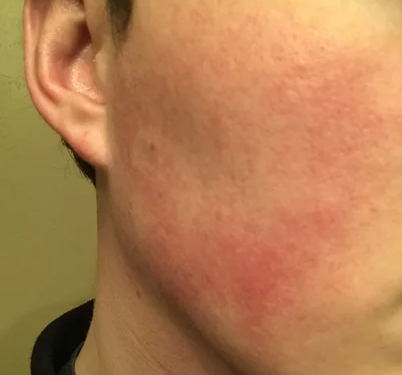Keratosis pilaris rubra (KPR), also known as “red keratosis pilaris,” is a specific subtype of keratosis pilaris (KP) characterized by red, inflamed bumps on the skin. These bumps are often surrounded by a reddish halo, which differentiates KPR from other forms of KP that might have white or skin-colored bumps. The underlying cause of KPR is the same as other types of KP: the buildup of keratin around hair follicles, leading to blockages and the characteristic bumps.
Treatment
Managing keratosis pilaris rubra involves a combination of exfoliation, moisturization, and other treatments to reduce inflammation and improve the appearance of the skin.
- Gentle Exfoliation:
- Use mild physical exfoliants like soft brushes or exfoliating gloves to help remove dead skin cells. Avoid harsh scrubbing, as it can worsen inflammation.
- Consider using chemical exfoliants containing alpha hydroxy acids (AHAs) like glycolic acid or lactic acid. These can help improve cell turnover and reduce the appearance of red bumps.
- Moisturization:
- Use a gentle, non-comedogenic moisturizer to keep the skin hydrated. Look for products that contain ceramides, hyaluronic acid, or glycerin.
- Applying moisturizer regularly can help reduce dryness and soothe inflammation.
- Topical Treatments:
- Over-the-counter creams or lotions containing salicylic acid can help exfoliate and unclog hair follicles, reducing redness and inflammation.
- Prescription-strength creams containing retinoids can promote cell turnover and reduce the appearance of bumps.
- Avoid Irritants:
- Fragrances and harsh chemicals can further irritate sensitive skin. Opt for fragrance-free and gentle skincare products.
- Sun Protection:
- Protect your skin from the sun’s harmful rays by using a broad-spectrum sunscreen. Sunscreen can prevent further inflammation and redness.
- Consult a Dermatologist:
- If over-the-counter products don’t provide the desired results, consider consulting a dermatologist. They can recommend prescription-strength treatments tailored to your specific needs.
Causes:
- Genetics: KP rubra often has a genetic component and tends to run in families. It is more common in individuals with a family history of the condition.
- Keratin Buildup: The condition is caused by the buildup of keratin, a protein that protects the skin. In KP rubra, keratin forms a plug inside hair follicles, leading to the development of small red bumps.
Appearance:
- Red Bumps: The primary characteristic of KP rubra is the presence of small, red, or inflamed bumps on the skin. These bumps can be surrounded by slightly reddish or pinkish skin.
- Texture: The affected skin can feel rough or “sandpaper-like” to the touch.
- No Pain or Itching: KP rubra is typically not painful, and it usually doesn’t itch. It’s considered a cosmetic concern more than a medical one.


Here are some tips and products that might be helpful for managing KPR:
Keratosis Pilaris Rubra – red bumps on the arms, head, or legs.
Keratosis Pilaris Rubra Faceii – red rash on cheeks.
Remember that managing keratosis pilaris rubra is an ongoing process, and results might take time to become noticeable. Consistency in your skincare routine and patience are key. A dermatologist can provide personalized advice and treatment options based on your skin’s condition and needs.
